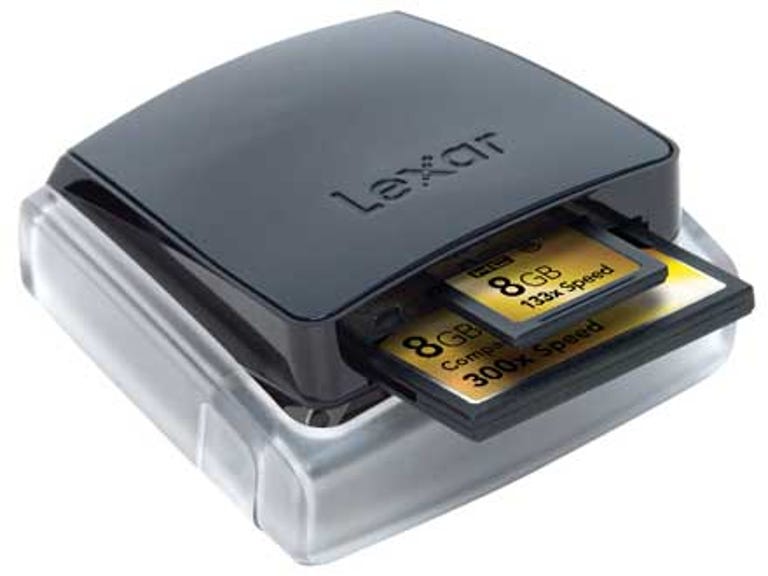 Why You Can Trust CNET
Why You Can Trust CNET Lexar Professional UDMA CompactFlash Dual-Slot Reader review: Lexar Professional UDMA CompactFlash Dual-Slot Reader
Most users won't need Lexar's Professional UDMA reader, but if you're already deep in the high-capacity, high storage flash market, it's a great buy.
Design
If you're going to label something as "professional", it had better look the part, and despite being of distinctly plastic construction, the Lexar Professional UDMA CompactFlash Dual-Slot Reader does a pretty good job of it. It's a two-slot card reader with a pop-up design; you simply press on the piano black card reader body and it jumps up, presenting an SD card slot resting above a naturally larger CompactFlash slot.
The Good
The Bad
The Bottom Line
The rear of the unit houses a mini USB connector — a cable is provided — and that's pretty much it for the Lexar Professional UDMA CompactFlash Dual-Slot Reader's design. It's simple, it's lightweight, and for those looking at it from a photography viewpoint, the pop-up design makes it nicely portable, as it's easy to stow away without risking the pin connectors in any way.
Features
Card readers aren't quite ten a penny, but they're pretty darned close — we've seen supermarkets selling multi-card readers for under 20 bucks quite recently, so for about three times that, the Lexar Professional UDMA CompactFlash Dual-Slot Reader needs to really stand out. It does this through support of faster and larger card standards — specifically, support for SDHC cards and UDMA (CF 4.0) CompactFlash cards.
If you're scratching your head at either appellation, then it's probably fair to say that the Lexar Professional UDMA CompactFlash Dual-Slot Reader isn't for you — at least, not yet. Both SDHC and UDMA CompactFlash change the standards for both flash memory formats, offering much greater storage capacities (primarily through the use of FAT32 file systems) and faster transfer speeds. There's nothing wrong with existing CF and SD cards — and the Lexar Professional UDMA CompactFlash Dual-Slot Reader supports those too — but for those using flash-heavy resources (such as most Digital SLR cameras) the size constraints and speed restrictions of those formats make quick shooting and image transfer a real pain. It's this market that the Lexar Professional UDMA CompactFlash Dual-Slot Reader addresses, at least until SDHC and UDMA CF become more commonplace. This is just a matter of time, however, with systems such as ASUS's highly popular EeePC utilising an SDHC card slot, for example.
The Lexar Professional UDMA CompactFlash Dual-Slot Reader is a strictly two-card format reader, however, so those using either xD or Memory Stick formats will most distinctly have to look elsewhere.
Performance
In order to get the most out of the Lexar Professional UDMA CompactFlash Dual-Slot Reader you'll not only need the reader itself, but compatible media. Stick any old SD or CF card in there, and you'll get results that are only as good as the media itself. We threw a variety of Flash media at the Lexar Professional UDMA CompactFlash Dual-Slot Reader, including a UDMA CF card supplied to us by Lexar, in order to get a feel for the reader's average performance. Bear in mind that your own results will rely on the quality of the media presented; most photographic flash memory usually reflects this as a speed rating, while cheaper cards omit this kind of information entirely.
The combination of better quality media — especially CF, which in the pro photographer market is still ruggedly king — does yield good results, whether you're reading pictures off a card, or just utilising your SLR's burst mode for rapid shooting.
If you don't utilise higher speed/capacity cards, then there's clearly no reason not to opt for the AU$20 cheapy card readers. If you're after a professional product that has good build quality and support for faster and newer formats — and can live without xD and Memory Stick support — then the Lexar Professional UDMA CompactFlash Dual-Slot Reader is a good reader option.
| Memory card type | Memory card capacity | Average Read/Write speeds |
| Generic SD | 256MB | 11.3/5.5MBps |
| SanDisk Extreme Ducati SDHC | 4GB | 13.3/12.9MBps |
| Lexar UDMA 300x CF | 2GB | 33.4/29.6MBps |


